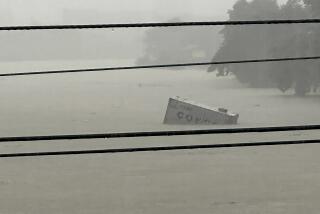Typhoon Dims a Philippine Bright Spot : Economy: ‘It’s like an atomic bomb has hit us,’ a senator says of Cebu, the nation’s second-largest city and center of a thriving area.
- Share via
MANILA — A devastating typhoon that left at least 180 people dead, 370,000 homeless and tens of millions of dollars worth of damage in the central Philippines earlier this week also battered the only bright spot in a national economy facing its gravest crisis in years.
Four days after the “super typhoon” called Mike slammed into Cebu, the nation’s second-largest city and most thriving economic area remained largely cut off from the outside. The city is the heart of trade, transport and communications for the central and southern Philippines, and nearby beaches are among the nation’s most popular tourist attractions.
Officials said peak winds of 150 m.p.h. knocked out power, phones, factories and port facilities and wiped out several luxury resorts. Mactan International Airport was isolated after the storm pushed a Korean freighter into the bridge that leads to the city.
At least 57 boats and ships were sunk, crippling the region’s commercial fleet, and prime sugar cane, coconut and rice growing areas were severely damaged on Negros, Panay and Leyte islands. President Corazon Aquino, who will fly by helicopter to Cebu this morning with visiting Rep. Stephen J. Solarz (D-N.Y.), has declared 29 provinces and 24 cities disaster areas.
“It’s like an atomic bomb has hit us,” Philippine Sen. John Osmena told reporters here after visiting Cebu. “There is no electric post standing, no tree stands, no light, no water, no telephone, no gasoline.”
At least 178 people are reported missing, and the death count is likely to rise significantly. “There are still many areas that we have no reports from yet,” Crispina Abat, operations chief for the Philippine Civil Defense office, said Friday night.
The destruction in Cebu hits especially hard, since the city has been the only success story in a year that has seen a sharp reversal of the nation’s four-year economic expansion.
The city of 2.5 million has seen a construction and export boom since 1987 and posted annual economic growth rates of up to 20%. More than 129,000 tourists were expected this year, drawn by international advertisements that often don’t mention that Cebu is located in the coup-prone, violence-torn Philippines.
The national picture is far grimmer. Buffeted by political instability, natural disasters and the Persian Gulf crisis, economic growth this year is below 3%, barely half last year’s rate.
The heavily indebted nation is still recovering from a prolonged drought last spring, a crippling power shortage in Manila that idled thousands of factories and businesses, and a July 16 earthquake that killed at least 1,600 people and devastated the resort city of Baguio and surrounding areas in northern Luzon.
The gulf crisis has crushed hopes of an early recovery. Rising fuel prices, a ballooning trade deficit, 15% inflation, an 8.7% devaluation of the peso and the loss of critically needed foreign exchange from overseas workers have left the country reeling. Leftists demanding higher wages have repeatedly fought police, most recently in a street battle Friday that left two dead.
In a speech last month, Jose Concepcion, the trade and industry secretary, said the nation has one year to put its economy in order or face disaster. “This will be the most crucial year for our republic,” he said.
An International Monetary Fund team arrived here Wednesday to negotiate a new 18-month stabilization plan after the Philippines failed to meet targets set under its existing agreement. Noncompliance puts billions of dollars of balance-of-payments supports and related projects in jeopardy.
“This place could become like Argentina or Peru” if the economy is not brought under control, said one official close to the talks.
Even before the typhoon, the bleak investment climate dimmed this week when the Philippine Supreme Court issued a ruling that effectively blocked a Taiwanese industrial group’s plan to build a $370-million petrochemical plant. The complex would have been the largest foreign investment in the Philippines since Aquino took office in 1986.
In its ruling, the court paraphrased an early Filipino nationalist leader, saying it is better to have “a government run like hell by Filipinos than one subservient to foreign dictation.”
More to Read
Sign up for Essential California
The most important California stories and recommendations in your inbox every morning.
You may occasionally receive promotional content from the Los Angeles Times.














